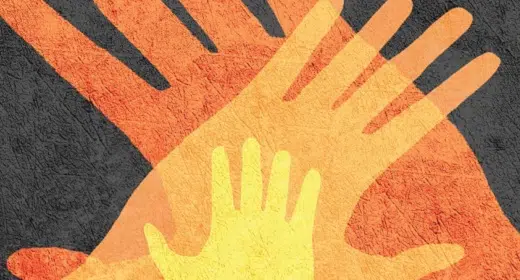by Sebene Selassie: Granting ourselves permission to feel can help us find acceptance…
Society leads us to think all pain is a mistake. This leads us into constant contention with reality. Discomfort, disease, illness, aging, limitations, and any and all ailments of the body are part of the deal of embodiment. It’s hard to experience belonging in a body that we believe is somehow wrong or faulty. Yet, we can behave as if any unwelcome change in the body is unjust, as Pema Chödrön says, as if “pain is a punishment.” Being diagnosed with cancer at such a young age felt like a huge punishment. I could not understand why I—an early (American) adopter of yoga, meditation, and all the woo-woo—got the big C. I must have done something wrong. I did smoke in my twenties. And there was all the partying. Oh, and the accompanying drugs. But lots of people did that and they didn’t get stage-three cancer. Lost in lamentation, I recited, “Why me?” It was only when in the hospital with kidney failure, awaiting news about whether I would undergo a risky surgery (luckily, I did not) that I released that thought.
I was alone in my room, in pain, frustrated. Visiting hours had passed. Smartphones had yet to be invented. I had no friends or apps to distract me. I was ready to press the red button to call a nurse for drugs when I glanced at the front page of the newspaper lying next to my head. There was a photo of a woman in Darfur, probably younger than me at the time. She was emaciated and held in her arms her dying baby, whose skeletal face gazed up at its mother as she stared into the lens of the camera. In that moment, I thought “Why not me?” What made me think I should be free from pain? Almost two million people are diagnosed with cancer in the US every year. Over half a million die, including thousands of children. Comparison led me to evaluate myself in relation to my friends who were healthy, raising families, seemingly not in pain.
Pain felt like a punishment. I felt like I did not belong. But I belong to pain too. We all do. Mindfulness invites us to get comfortable with this reality.
As I removed the “oh, woe is me” story about pain, I had an opportunity for embodied awareness. Letting go of my stories, I used my practice to check in to what exactly was happening. I attuned to sensations and felt a stabbing in my abdomen, the same I’d been feeling for weeks. It was not pleasant, and it was familiar and tolerable. I acknowledged that if it got worse, I could call someone to help me relieve it. For that I gave thanks. I allowed myself to rest in a place of gratitude. This made space for me to continue feeling the sensations. I followed my breath in the belly; it eased the pain just a little. I rested in that moment. Turning back to the paper, I considered the woman in the picture again and sent a silent prayer for her ease.
Embodied awareness has helped me manage pain better. We can bring empathy to ourselves by meeting pain with embodied awareness, curious about the sensations. It’s not that we long for the pain to continue. We can aspire for a release from pain, but we bring kindness and compassion to whatever is happening. We accept what’s there, without contention. Kindness and curiosity, aspiration and acceptance—these are the keys to belonging.
Whether the pain is physical or emotional, we long for a release. In our attempt to get away from it, we limit our capacity to feel it, thinking that will protect us. Instead, it limits our capacity to feel at all.
We live in a culture that glorifies pleasure without even actually teaching us to feel it. Pleasure becomes a fetish and a status symbol, not an embodied experience. Those in society who experience more material ease and better fit the culture’s idea of a pleasurable life (i.e., having more stuff ) are deemed better off. But fame, money, and power do not necessarily make you free or joyful. If we were better able to feel the sensations of pleasure and pain, perhaps we would not be desperately grasping for the former and compulsively avoiding the latter, swinging between the emotions of happiness and sadness about the two.
Neuroscientist Lisa Feldman Barrett explains how emotions are made in her book aptly titled How Emotions Are Made. She distinguishes between three biological states (pleasant, unpleasant, and arousal). These are physical experiences. Our various interpretations of them constitute our range of emotions (liking, disliking, fear, sadness, happiness). Pleasant, unpleasant, and arousal are states felt somatically by all humans; however, there is no similar cross-cultural reality of emotions. What we in America deem “sadness” has no direct equivalent in Tahitian culture. In similar situations where we would feel sad, they feel something more akin to “the kind of fatigue you feel when you have the flu.” Barrett believes our emotions are culturally learned habits that we add onto the physical sensations of pleasant, unpleasant, or arousal. She states: “This is partly why mindfulness meditation is so useful to people who have chronic pain—it lets you separate out the physical discomfort from the distress.”
You know who else figured this out? The Buddha. One of the central practices in the teaching on mindfulness is around what’s called vedana. Often translated as “feeling tone,” it describes how every experience contains a quality of pleasant, unpleasant, or neutral. Every sensation and thought, every moment in life can be categorized by one of these three qualities. We add emotion on top of these qualities. We tend to like the pleasant and dislike the unpleasant and ignore the neutral—and thereby watch Netflix rather than work on our book, press the red button for drugs we don’t necessarily need, or don’t notice the color of the sky at sunset.
The past few years I have met one of the most profound spiritual teachers of my life. It’s called menopause. When I was forty-five, after my third diagnosis and second time with stage-four cancer, I had my ovaries removed as part of my treatment. This thrust me into early and full-blown menopause. When they first started, my hot flashes were at their most intense. In New York City summer heat, I felt like I was set aflame from the inside (extremely unpleasant). I was also more irritable than usual, grumpy, and quick to be reactive. I assumed that this was an overall side effect of the hormonal changes—until one fall morning. I was sitting at the kitchen table drinking tea. My mind was wandering here and there when I noticed some irritation surfacing. An annoyance I had about something my husband did popped into my mind. Having practiced for years with difficult thoughts and emotions, I immediately went to my body to sense into my experience. I brought attention to my belly and I noticed some very subtle tingling. Using embodied awareness, I kept my attention there. It was about thirty seconds later that I realized a hot flash was arising. This is when I made the connection. Is my irritation being caused by the initial feelings of the hot flash? I was getting irritated at the very first stirrings of the hot flash, before the heat. By the time the hot flash arrived, I was disgruntled. My husband’s actions were simply a habituated place for me to project the irritating sensations that my body felt but that my mind had not yet registered. I had become accustomed to being annoyed by my husband, something I may have learned in my family— I come from a long line of women who were (perhaps rightfully) annoyed by their husbands. That habit inclined me to be annoyed by him when in fact he was not even there, not even doing or not doing something annoying.
I recognized that my thoughts about menopause may have been affecting my experience of it. As my sex drive lessened and my body changed with the drop in hormones, I developed a similar “why me” bitterness that I had had in the early years of cancer. I was disgruntled about having to deal with this experience “before my time.” None of my peers were facing menopause yet. My husband would never have to contend with hot flashes. Older women are barely acknowledged in our culture. I could already feel how I was less acknowledged or appreciated in certain spaces, how I would soon become irrelevant. Those old feelings of not belonging were being stirred. Since then, whenever an annoyance, a difficult emotion, or an upsetting thought arises, I “treat it like a hot flash.” I recognize that there’s a chance a true hot flash will arise (happens more often than not) but that there is likely a physical experience of “unpleasant” that is happening somewhere in my body and I am projecting my emotions onto it. My emotions are a habit.
Practice offers the possibility of staying with an unpleasant experience, bringing curiosity and kindness.
This doesn’t mean we have to dismiss all pain, physical or mental. I am simply inviting us to bring more embodied awareness to whatever is happening. It can be easy to go into an instinctual not-liking mode when it feels like someone just turned a furnace on full blast inside your body. I can try “fixing” my hot flash by immediately fanning myself or sticking ice cubes down my shirt (yes, I’ve done that). I could project onto an emotion or mental habit. But practice offers the possibility for a different response: it’s an opportunity to practice staying with an unpleasant experience, bringing curiosity and kindness. Instead of immediately pushing it away, I can notice what it really feels like. I can bring awareness to the sensation of heat.
With embodied awareness, every time I experience a hot flash, I drop any story and allow myself to simply feel the heat. When I did, you know what I noticed? Heat. That’s all. Heat is hot. I can even recognize that there are other times when I love being hot, like at the beach or in the sauna or when I take a hot bath . . . which I do almost every damn night. I enjoy those times of steaming hot heat. But I control those moments. I can’t control when I feel a hot flash and, ultimately, I don’t like change. There is another core teaching of Buddhism. That change or impermanence is a fundamental aspect of life. Every single thing in reality is changing all the time and we have no control over that. It’s said if we could truly understand this, even for a moment, we would achieve freedom and lasting happiness. But there’s a hitch: we don’t like change—not wrinkles, not down times, not loss, and certainly not death. Not menopause either. And now that I admit I cannot control or change my hot flashes, do I suddenly love them? No. It’s not like I wish them to arrive or celebrate every one of them. But I can develop a different relationship to them. I don’t smother them in my expectations or moods. I give them space, and me too. I allow myself to feel them, and this makes me a lot less miserable about them.
We long to live with more freedom, with joy, with love. This begins in the body. The teachings of mindfulness instruct us to first know what is happening as a felt sense and then to cultivate an attitude of curiosity and kindness toward it. I cannot control my hot flashes, and someone else cannot will away their chronic pain. But I can notice when I feel irritated or when I feel heat rising and meet it with openness and acceptance—that’s how we find ease. Sometimes it’s said like this: It’s not what’s happening that matters, it’s our relationship to it. In the beginning of our meditation practice, we may think we need to make something happen, but, in fact, by relating differently, we are practicing belonging.














































